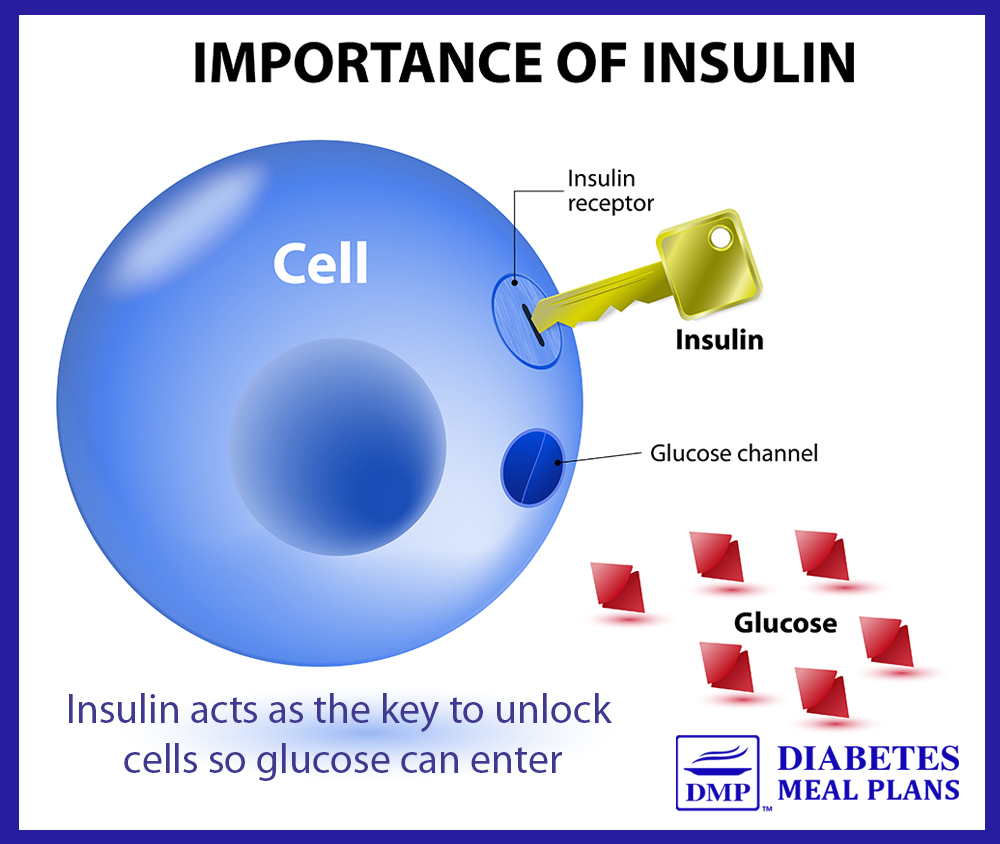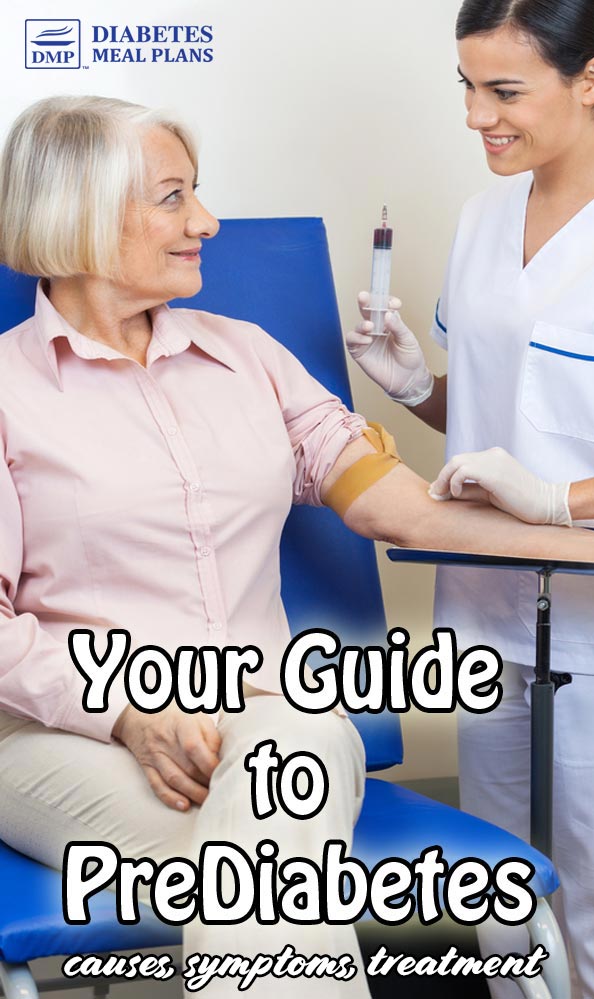Table of Contents[Hide][Show]
What Is Prediabetes?
Prediabetes is a condition where blood glucose levels are higher than normal, but not yet high enough to officially be diagnosed with type 2 diabetes. And it all comes down to the hormone insulin, which is produced by an organ called the pancreas.
Take a look at the picture below.

You can see by the picture that insulin acts as a ‘key’ to unlock cells in the body, so that glucose (sugar) can move out of the blood stream and into the cells.
But what happens in prediabetes, is the key starts to falter, it’s no longer able to open the lock every time. This is called insulin resistance.
During prediabetes, the pancreas is often overworking, producing higher amounts of insulin (hyperinsulinemia) to try to get blood glucose levels lower.
And unfortunately, the combination of higher glucose and insulin in the blood stream causes the body’s cells to become more resistant to the insulin – meaning, though the pancreas is pumping more insulin, your cells are still not responding effectively.
You can have pre-diabetes/insulin resistance for 5-10 years before an ‘official’ diagnosis and for this reason diabetes often gets overlooked, meaning many people are walking around not knowing they are living with prediabetes or diabetes.
Why It’s Important To Take Action With Prediabetes NOW
An important point to mention is that a lot of the damage to the body occurs during this insulin resistant phase, during the prediabetes stage, because it’s the insulin resistance and consequently the high insulin and blood glucose levels that cause havoc in all the body’s cells, increasing inflammation and driving the development of complications like heart disease, nerve issues that result in tingling and loss of sensation in the hands and feet, eye issues, kidney issues – you don’t want any of these things to happen, right?
If you have prediabetes, take action and do something NOW – the sooner you take action, the sooner you can reset your prediabetes health back to normal.
Prediabetes Symptoms
Unfortunately, there are usually no symptoms associated with prediabetes, which is why it can go undiagnosed for a long time.
Even when people know they have prediabetes, people often don’t take it seriously until they start experiencing pain or discomfort – like tingling in the hands and feet, for example.
It is very important to take action before symptoms appear, as this is your best shot at preventing complications and possibly even a full blow diabetes diagnosis.
An exception to having no symptoms, is the appearance of dark spots on the back of the neck, armpits or elbows in some people, called Acanthosis Nigricans.
However, this is not common to all people with diabetes so the best way to screen is to have your blood glucose checked periodically with your doctor.
Prediabetes Blood Sugar Levels
Diagnostic ranges for prediabetes are as follows:
- Fasting blood glucose that ranges between 100-125 mg/dL (5.6-7 mmol/L)
- Hemoglobin A1c levels between 5.7-6.4 USA (6.0-6.4 Canada, UK, Australia)
- Oral Glucose Tolerance Test (OGTT) 140-199 mg/dL (7.8 11.1 mmol/L) – although this test is used less frequently
Risk Factors for Prediabetes
Risk factors that increase your odds of developing prediabetes are similar to type 2 diabetes.
You should be tested if you are:
- Overweight (this is the top risk factor)
- Large waist size (>35 in women or >40 in men)
- Hyperlipidemia/ high cholesterol (high LDL and triglycerides, low HDL)
- Sedentary lifestyle (lower activity increases risk)
- Older (risk seems to be higher after the age of 45)
- Family history (having a parent or sibling with diabetes)
- Ethnicity (people of Asian, African, Hispanic, Indian, or Pacific Island descent are at greater risk than Caucasian)
- Prior gestational diabetes (or having given birth to a baby >9 pounds (>4kg)
- Polycystic ovarian syndrome (PCOS)
- Sleep problems (sleep apnea, shift working)
What is the Prediabetes Diagnosis Procedure?
Both the fasting glucose test and A1c tests are simple. Blood gets drawn at the doctors office or via a pathology lab, providing you with a test result.
If OGTT is performed, the doctor will take a fasting glucose sample, then you get to drink a very sweet beverage containing 75 grams glucose and hang around for 2 hours. They will then take another sample to test the effect of the drink on your blood glucose.
If it is >140 (>7.8), you’ve not produced or utilized sufficient insulin to bring glucose levels back down to normal healthy blood sugar levels.
It is rare that a doctor will diagnose you with prediabetes off one test only; as the medical care guidelines suggest that doctors do two tests to confirm a diagnosis. For example, they may conduct an A1c and fasting glucose test on two different occasions to confirm the result.

How Do You Cure Prediabetes?
In many cases prediabetes can be reversed to normal glucose levels – you can reset your prediabetes health!
In fact, it is much easier to reset blood sugar balance back to normal, than if you’re already diagnosed with diabetes. There is great evidence to suggest that small changes can prevent a new diabetes diagnosis in 50-70% of cases.
The longer you leave it, the greater the chance of developing metabolic derangements (negative changes in your body); then, the harder it is to achieve normal control.
So if you or someone you know has been diagnosed with prediabetes, NOW is the time for urgency!
The good news is, you can reset your prediabetes health, and you can do it naturally through nutrition and lifestyle.
How To Treat Prediabetes
The best form of treatment for prediabetes is nutrition and lifestyle, so you can target key areas that influence your metabolism directly.
Improvement in Diet/Nutrition
Diet and nutrition are your primary treatment strategy, because what you eat directly targets factors such as boosting metabolism, promoting fat burning and weight loss, and positively influencing hormones.
A couple of tips include:
- Follow a balanced carb-controlled diet consisting of lots of non-starchy vegetables, unprocessed protein foods and healthy fats.
- Avoid sweetened beverages, pre-packaged snack foods, deep-fried choices, ‘added’ sugar, refined white flour and hydrogenated oils.
Weight Loss
- If you are overweight, losing weight is likely to have the most significant effect on reducing your risk for developing diabetes.
- Weight loss as little as 5-10% has been shown to produce great results.
Exercise
- Regular consistent exercise is key to reversing insulin resistance and for weight management. Plus, it helps build strength and energy.
- Walking, yoga, squats, leg lifts, and bridges are all examples of simple activities you can try to include in your exercise routine.
Improved Sleep Habits
- Sleep is crucial to proper healthy hormonal maintenance, including hormones needed to regulate blood glucose levels.
- Check out this article for tips on the importance of sleep and tips on getting better sleep.
Metformin and Prediabetes
Metformin is sometimes, but not always prescribed in prediabetes.
It is a often used as a first line medication for people who don’t have kidney problems as it’s low cost, does not cause weight gain, and may even help with weight loss.
But, keep in mind that relying on medication is not the answer. Research shows that diet and nutrition are more effective than medication. And here at DMP, we support people to deprescribe medications, working with your doctor or course.
Can You Reverse Prediabetes?
Absolutely YES!
Our Prediabetes Reset Program is designed to support you to reverse/reset your health back to normal and we see it happen with our members all the time.
Here’s what Cheryl said:
“Last week I went in for my yearly physical and my A1c was 5.5! The doctor had told me that if I could keep my A1c under 5.7 for a year he would take me off metformin. So… I’m off metformin and you could say that I’m not pre diabetic anymore! I no longer experience tingling in my hands and feet. My blood pressure, and triglycerides are normal. I no longer have UTI’s and I’ve lost weight, and I feel better. Thank you DMP and your sincere staff. You are doing wonderful work. “
What you eat has the biggest influence on blood sugar levels, and if you choose the right foods, you can control or reverse prediabetes!


Dottie Webb
I need a meal plan or food list so I will know what to eat or foods to avoid
Dr Jedha
Hi Dottie, It looks like you already requested our food list and we sent it to you via email so please check your inbox—that should get you started on the right track. For meal plans and extra support to reverse your prediabetes, consider joining us as a member, or taking the Prediabetes Reset Program.
Iris Walls
I’m trying my very best to reduce my weight by eating only natural foods, with non-fatty meats, oily fish, salads, eggs, non/starchy vegetables. I eat only 1-2 slices of bread each day, rarely eat potatoes, pasta and rice. I lost over 1 stone in weight last year, but now I’ve plateaued. I’m disabled. Exercise is difficult for me. I only get about 3000 steps a day on my Fitbit. I don’t know what else I can do.
Dr Jedha
You don’t need to exercise to lose weight Iris, as diet/nutrition are the key to effective and sustainable weight loss. Start with a food diary, as this will give you a clearer picture. After you keep your food diary for a few days, take a good hard look at it and circle any problem areas you can work on. You still might need more food variety or to adjust your carb intake or other elements. Other things that can impact weight loss are sleep, hydration and medications too, so consider those. For more help and support, consider joining us as a member, which includes monthly member check ins to address any challenges.